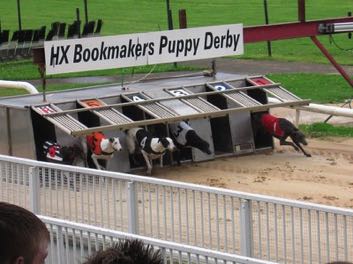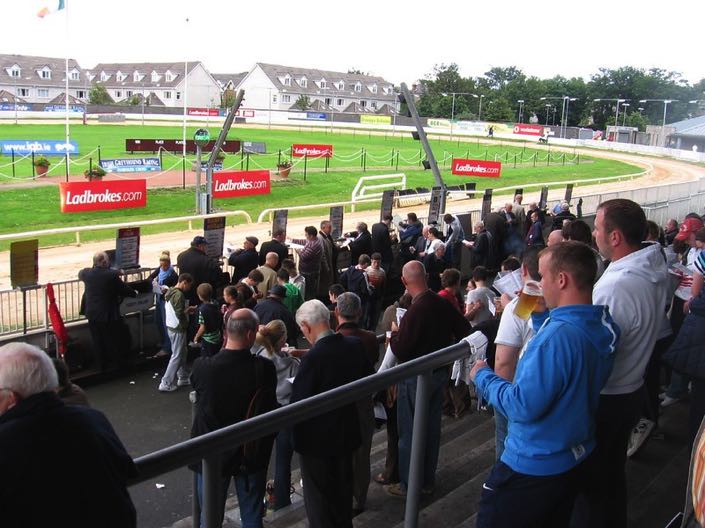- Address: 6 Harold’s Cross Rd, Rathmines, Dublin 6W, Ireland
- Status: Permanently Closed

As the years have passed since the time when greyhound racing was at its zenith, numerous dog tracks up and down the country have closed their doors for the final time. Despite being located in Ireland, Harold’s Cross Stadium is no exception to this, having first opened its doors in 1928 before shutting them for the final time in 2017. Owned and operated by the Irish Greyhound Board, the venue boasted the likes of a restaurant, a carver, a totalisator betting board and seating for the people that went there to watch the racing.
If you wanted to, you could head to Harold’s Cross every Tuesday and Friday evening in order to see greyhounds race across distances including 325 yards, 525 yards, 550 yards, 570 yards and 750 yards. In the end, it was shut down for a reason as old as time itself: financial. It was believed that the proceeds from the sale of the venue were to be used to pay off debt incurred in the building of Limerick Greyhound Stadium, which remains standing to this day. Also owned and operated by Greyhound Racing Ireland, the newer venue operates on Thursday and Saturday evenings.
Major Races & Events
As is so often the case with greyhound racing venues, Harold’s Cross was the home of several important greyhound races. When it comes to Irish racing, many of these events are versions of ones that already exist in the United Kingdom, much as the Irish Grand National is the emerald isle’s version of the horse race that takes place at Aintree Racecourse every April. Sometimes, though, the races are nothing to do with events hosted in the UK and are just their own thing. Here’s a look at some of the events hosted at Harold’s Cross:
Corn Cuchulainn
With a name like the Corn Cuchulainn, it’s impossible to imagine of a race taking place in the United Kingdom with the same title. Instead, this is one of Irish greyhound racing’s major competitions and it was ran at Harold’s Cross over 750 yards between 1963 and 2016. It was briefly known as the Sean Kelly in 1980, having enjoyed numerous different sponsored titles over the years. Run on a sand surface, the race has taken place at Shelbourne Park since 1961.
Puppy Derby
Also known as the Juvenile Derby, the Puppy Derby is the Irish equivalent of the race of the same name that was held at Wimbledon Stadium in the United Kingdom. Run over 525 yards on sand, it is open to puppies aged between 15 and 24 months and the winner gets €20,000. It was inaugurated at Harold’s Cross in 1943, moving to Shelbourne Park for one year in 1999 before returning in 2000 and remaining there until Harold’s Cross closed in 2017. At that point it returned to Shelbourne Park, but its association with Harold’s Cross will forever be in history.
Another race that is the Irish equivalent of a British race, the Grand National was actually inaugurated at Shelbourne Park back in 1928 before taking place intermittently at Harold’s Cross in the years that followed. It moved to the venue permanently in 2001, remaining there until the venue’s closure, at which point it went to Curraheen Park. Run over hurdles across 525 yards, it is Ireland’s leading hurdle event and is considered to be one of the country’s most important races during the greyhound racing calendar. Only hurdlers can enter it, which has been the case since its first running.
In the News
As you might imagine for a greyhound racing track that has closed down, the only reason Harold’s Cross appear’s in the news nowadays is for sad purposes. In February of 2022, for example, the stadium was mentioned alongside a news story that Shelbourne Park’s owners were looking to rezone it for housing, meaning that greyhound racing in Dublin would be no more. Shelbourne Park became the city’s last venue for the racing of greyhounds following the 2017 closure of Harold’s Cross, now Pembroke Estates Management believing that 750 homes could be built on Shelbourne Park.
About Harold’s Cross Greyhound Stadium

Located in the Harold’s Cross area of Dublin, Harold’s Cross Stadium was initially used for both greyhound racing and speedway. The speedway only lasted a year, but that wasn’t the end of the place as a multi-sports venue. Five different football teams used the stadium over the years, all of whom were competing in the League of Ireland. Brideville were the first to do, calling Harold’s Cross their home between 1929 and 1932, then again between 1935 and 1943. The Dolphins played there from 1932 to 1934, with Transport moving in for 11 seasons in total.
Shelbourne played at Harold’s Cross over four seasons in total before they moved to Tolka Park, whilst St Patrick’s Athletic were the final League of Ireland club to play there regularly. They did so from 1989 until 1993, using the venue whilst their home ground of Richmond Park was being renovated. During the time of its existence, Harold’s Cross hosted numerous important matches, including the League of Ireland Cup Final between Limerick City and St Patrick’s Athletic in 1993. Galway United played the last match there against Shelbourne on the last weekend of the 1993-1994 season.
The Early Years of the Greyhound Racing Venue
Though Harold’s Cross played host to both football and speedway during its existence, there is no question that it was best known as a greyhound racing venue. Indeed, if it hadn’t been for the popularity of the sport then it never would have existed in the first place. A new Irish company called the Dublin Greyhound and Sports Association Limited was formed on the 13th of February, 1928. The directors were a timber merchant called J. B. Fraser and a retired public official called John J. Flood, alongside architect, Walter Butler, and gentleman, Edward Teehan, plus John McEntagart, a motor engineer.
Alongside one another, these men opened Dublin’s second greyhound track following Shelbourne Park, which had opened in 1927. The first race took place on the 10th of April 1928, following advertising in the Irish Times that said that it could host up to 40,000 people and accept 1,000 cars in the car park. The race that would go on to become the Irish Greyhound Derby was inaugurated at the racecourse not long after it opened, though it was unofficial initially because the venue ran it without consulting the rest of Irish racing.
The Pre-War Years
In 1929, just a year after the venue had opened, Mick the Miller came to the course and won the Spring Cup at Harold’s Cross before finishing as the runner-up in the Stayers’ Cup. He racked up several wins in Ireland before heading across the water and becoming one of the first great greyhounds to compete in England. Whether his success at Harold’s Cross had any influence in the Irish Coursing Club awarding the course with the Oaks and not the Derby when it released a list of new Classic races in 1932 is difficult to tell, but it caused controversy nevertheless.
Five years later and Harold’s Cross was finally granted the right to host the Derby, on the proviso that £100 was contributed towards it. The ICC then put a further £50 towards the event and a decision was made to alternate the hosting of the race between Shelbourne Park and Harold’s Cross each year. The first major star of the track was discovered in 1938, with a bitch called Nanny Goosegog, who belonged to the track vet, winning 37 of her 38 races at the track, but they weren’t counted officially as some of them were handicaps.
After the War
Having introduced the Puppy Derby in 1943, the track became the first in Ireland to use automatic starting gates the following year. As with most greyhound racing venues, there were limited other goings on during the Second World War. In the wake of it, however, things continued to go from strength to strength. Spanish Battleship won the first of his Derby titles in 1953 then won it again the following year, resulting in the stadium being overwhelmed by crowds attempting to see him take it on, and win it, for the third time in 1955.
Changes occurred in the years that followed, such as the Bord na gCon funding the installation of a new totalisator system in 1960 and the Irish Greyhound Board buying the stadium a decade later. In 1977, considerable improvements took place at the track, including a restaurant and other facilities being put in place. A period of stability followed, only changing in the early 1990s when rumours about redevelopment of the track emerged. After a tough period, business improved and the rumours went away for a time.
Records at Harold’s Cross
Here is a look at the track records that are forever embedded in history thanks to the IGB’s decision to close down Harold’s Cross:
| Distance | Record Time | Date Set |
|---|---|---|
| 325 Yards | 17.16 Seconds | 2nd September 2005 |
| 330 Yards | 17.52 Seconds | 9th April 1999 |
| 525 Yards | 28.15 Seconds | 21st September 2001 |
| 550 Yards | 29.65 Seconds | 6th July 2001 |
| 570 Yards | 30.94 Seconds | 19th December 2009 |
| 575 Yards | 30.83 Seconds | 24th November 2002 |
| 750 Yards | 41.45 Seconds | 24th June 2005 |
| 810 Yards | 45.17 Seconds | 28th May 2010 |
| 830 Yards | 46.72 Seconds | 23rd June 1995 |
| 1,010 Yards | 56.82 Seconds | 19th December 2008 |
| 1,015 Yards | 58.32 Seconds | 10th January 2003 |
| 525 Yard Hurdles | 28.68 Seconds | 23rd October 2009 |
| 570 Yard Hurdles | 31.01 Seconds | 15th December 2006 |
| 575 Yard Hurdles | 32.43 Seconds | 25th February 2005 |
The Closing of the Track: What Happened to Harold’s Cross?
After constant rumours and speculation about the future of Harold’s Cross over the years, 2014 finally saw official news emerge that the Irish Greyhound Board were looking to sell it. The hope was that the sale would help to considerably reduce the IGB’s debts, most of which had been racked up by the building of Limerick Greyhound Stadium. The thought process was that the operations would all move over to Shelbourne Park, but many in Irish racing, especially those working at Harold’s Cross didn’t approve of such plans.
Eventually, the move to sell Harold’s Cross went through in 2017. The closure occurred on the 13th of February, with the IGB calming that the move happened ‘with regret’. All of the staff working there were offered employment elsewhere. The move was brought forward by the Irish Greyhound Board in order to create a ‘viable future for the industry’.